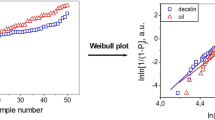Abstract
Fracture measurements have been made using a high pressure technique on three batches of uPVC corresponding to distinct levels of gelation.K c values correlate with methylene chloride attack in the established manner, but are low in comparison with room pressure values measured at comparable strain rates. This is linked with the presence of stress whitening on the fracture surface at room pressure, its absence at high pressure, and its diminution at room pressure when testing speed is increased, when lowK c values are also recorded. The results are successfully interpreted in terms of a multiple craze slow crack growth model, in which cracking in the tests at room pressure and slow speed is assumed to start at theK c measured at high pressure, and slow crack growth follows as the load on the specimen continues to increase until the specimen fails catastrophically. A reasonable choice of parameters then gives a good prediction of the observed collapse loads.
Similar content being viewed by others
References
K. V. Gotham andM. J. Hitch,Brit. Polym. J. 10 (1978) 47.
D. R. Moore, P. P. Benham, K. V. Gotham, M. J. Hitch andM. J. Littlewood,Plastics and Rubber: Materials and Applications (November 1980) 146.
D. R. Moore, R. C. Stephenson andM. White,Plastics and Rubber: Processing and Applications 3 (1983) 53.
G. P. Marshall andM. W. Birch,ibid. 2 (1982) 369.
M. W. Birch, M. D. Taylor andG. P. Marshall,ibid. 3 (1983) 281.
.A. Gray, “Application of a Rheometry Based Method to Assess the Fusion of PVC”, PRI International Conference “PVC Processing”, Royal Holloway College, Egham Hill (1978).
R. W. Truss, R. A. Duckett andI. M. Ward,J. Mater. Sci. 19 (1984) 413.
J. Sweeney,J. Strain Anal. 20 (1985) 1.
G. R. Irwin,J. Appl. Mech. 29 (1962) 651.
J. Sweeney, R. A. Duckett, I. M. Ward andJ. G. Williams,J. Mater. Sci. Lett. 4 (1985) 217.
A. Nadai, “Theory of Flow and Fracture of Solids”, 2nd edn. (McGraw-Hill, New York, 1950) p. 347.
R. A. Duckett,J. Mater. Sci. 15 (1980) 2471.
Y. Kaieda andA. Oguchi,Trans. Jpn. Inst. Metals 22 (1981) 326.
D. P. Rooke andD. J. Cartwright, “Compendium of Stress Intensity Factors” (HMSO, London, 1976).
G. D. Dean, L. N. McCartney, P. M. Cooper andS. Golding, “An Analysis of Crack Growth in PVC” (National Physical Laboratory, Teddington, UK, 1982).
L. N. Mccartney,Int. J. Fracture 16 (1980) 375.
D. S. Dugdale,J. Mech. Phys. Solids 8 (1960) 100.
ICI Ltd, Vinyls Group Technical Service Note W121, 2nd edn. (1980).
S. G. Larsson andA. J. Carlsson,J. Mech. Phys. Solids 21 (1973) 263.
Author information
Authors and Affiliations
Rights and permissions
About this article
Cite this article
Sweeney, J., Duckett, R.A. & Ward, I.M. The fracture behaviour of uPVC at both ambient and high hydrostatic pressures. J Mater Sci 20, 3705–3715 (1985). https://doi.org/10.1007/BF01113779
Received:
Accepted:
Issue Date:
DOI: https://doi.org/10.1007/BF01113779




